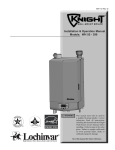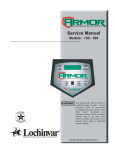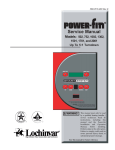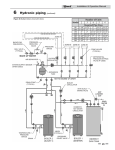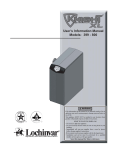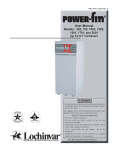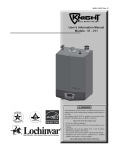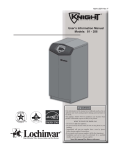Download KBN399 operation - MyHolidayLightSource.com
Transcript
11 Installation & Operation Manual Operating information General DHW / space heating (SH) cycling How the boiler operates If a DHW call for heat is received while a space heating call is in progress, the control will start the DHW pump and shut the boiler pump off. The system pump will remain on. If the space heating call is still active while the DHW call is in operation, the control will wait for 30 minutes (time adjustable by installer) then it will switch back to the space heating demand. The control will switch back and forth until one of the heat demands end. This function does not apply to cascade systems. The Knight XL uses an advanced stainless steel heat exchanger and electronic control module that allows fully condensing operation. The blower pulls in air and pushes flue products out of the boiler through the heat exchanger and flue piping. The control module regulates blower speed to control the boiler firing rate. The gas valve senses the amount of air flowing into the boiler and allows only the right amount of gas to flow. How the control module operates The SMART SYSTEM control module receives input from boiler sensors and external inputs. The control module activates and controls the blower and gas valve to regulate heat input and switches the boiler, Domestic Hot Water (DHW), and system pumps on and off as needed. The user programs the module to meet system needs by adjusting control parameters. These parameters set operating temperatures and boiler operating modes. Boiler operation can be based on boiler outlet water temperature, boiler inlet water temperature, or system temperature, depending on the parameter setting. Programmable controlling sensor The control module is programmed to use the outlet sensor as the control sensor by default. If a system supply sensor is connected, the control automatically uses it as the control sensor. The control sensor can be changed by the installer to the inlet sensor. If the inlet sensor is chosen as the controlling sensor, it is recommended that the system supply sensor be installed. Anti-cycling After a space heating demand has been satisfied, the control will delay the next space heating call for a set time period (time is adjustable by the installer). The time delay will be bypassed if the inlet water temperature drops too far during the delay. Control inputs and outputs Boiler, system, and DHW pump control Room thermostat / zone control When a space heating call for heat starts and no DHW call is on, the system and boiler pumps are turned on. As long as the space heating call for heat is on, the system pump will remain on. If a DHW call for heat is on, the boiler pump will wait to turn on until just before the DHW pump turns off. After the space heating call for heat ends, both pumps will run for an additional period of time. This input tells the boiler to provide water for space heating. Domestic Hot Water (DHW) tank thermostat This input tells the boiler to provide water for heating an indirect DHW tank. 0 - 10V input (set point or power) The Knight XL can be controlled by a Building Management System (BMS) using a 0 - 10 VDC signal. The control can be configured by the installer to use this signal to either control set point or firing rate. DHW priority The SMART SYSTEM control module allows connection of a DHW thermostat to the low voltage connection board. When the DHW thermostat calls for heat, the module activates the DHW pump, shuts down the boiler pump, and immediately sets the target outlet water temperature to 180°F (82.2°C). This provides automatic priority heat allocation to the indirect water heater for maximum response and recovery. The DHW pump continues for 30 seconds after the heating cycle to deliver the most possible heat. 56 When a DHW call for heat starts, the DHW pump is turned on. If a space heating call for heat was on, the boiler pump will turn off a few seconds after the DHW pump turns on. Temperature control Modulation The Knight XL is capable of modulating its firing rate from a minimum of 20% to a maximum of 100%. The firing rate is dictated by the call for heat (i.e., space heating or domestic hot water), the heating load, ramp delay (if enabled), and various other temperature limitations. 11 Installation & Operation Manual Operating information (continued) Ramp delay Protection features For systems with lower flow, the SMART SYSTEM can limit the firing rate (when enabled) when a space heating call for heat starts, or when switching from a DHW call for heat to a space heating call for heat. There are six (6) limits that can be programmed, as well as six (6) time intervals corresponding to each limit. The sixth limit will also limit the firing rate for the rest of the call for heat. Outlet temperature, flue temperature rise limiting Gradient limiting If during operation of the boiler the outlet water temperature is rising too quickly, the control will reduce the firing rate to its lowest setting. Outdoor air reset If an outdoor air sensor is connected, the control module will calculate the set point based on the programmed reset curve. The installer can change the slope of the reset curve by several adjustable parameters. The user can limit the maximum set point for the system using the space heating set point. Boost function If outdoor air reset is active, and a space heating demand has been active continuously for a set period of time (time adjustable by installer) and there has been no DHW demands, the control will increase the set point by a fixed number of degrees (adjustable by installer). This process will continue until the space heating demand ends, the set point reaches the programmed set point or a maximum of 20 increases has occurred. Once the system heat demand is satisfied, the set point will revert to the value determined by the reset curve. The control module monitors the flue temperature by a sensor located in the flue exhaust. If the flue temperature exceeds 215°F (102°C) the control will reduce the maximum fan speed. If the flue temperature exceeds 240°F (115°C) the control will shut the unit down. The unit will restart automatically once the flue temperature drops 25°F (-4°C) and the minimum off time has expired. The control monitors the temperature difference between the inlet and the outlet sensor. If this difference exceeds 55°F (13°C) the control will reduce the fan speed. If the temperature difference exceeds 60°F (15°C) the control will shut the unit down. The unit will restart automatically once the temperature difference has dropped below 55°F (13°C) and the minimum off time has expired. Freeze protection DO NOT install the boiler in a room likely to freeze. The following integral feature of the SMART SYSTEM control module provides some protection for the boiler only -- not for the system. • • The controller may be programmed to reduce the space heating set point during a certain time each day. A start and stop time can be programmed for each day of the week. • • To prevent nuisance shutdowns when the boiler is firing at minimum rates, the control will increase the firing rate when the flame signal drops too low. and The outlet temperature is monitored by the boiler outlet temperature sensor. When the outlet temperature exceeds 185°F, the unit will reduce the fan speed. If the outlet water temperature exceeds 195°F (90°C) the control will shut the unit down until it cools off. Night setback Flame current support temperature, The SMART SYSTEM control module provides freeze-up protection as follows when the boiler water temperature drops below 45°F (7°C): Below 45°F (7°C), the boiler and system pumps operate constantly. Below 37°F (3°C), the boiler turns on. Boiler and pumps turn off if boiler water temperature rises above 45°F (7°C). m CAUTION This feature of the SMART SYSTEM control module does not eliminate the possibility of freezing. The installation must still use recognized design, installation and maintenance practice to prevent freeze potential for the boiler and system. 57 11 Installation & Operation Manual Operating information Monitor external limits High limit operations Connections are provided on the connection board for external limits such as flow switch, low water cutoff, gas pressure switches, and an auxiliary device proving switch. The SMART SYSTEM will shut off the burner and inhibit relighting whenever any of these external limits open. When outlet temperature exceeds 200°F (93.3°C), high limit action occurs. The boiler shuts down until the outlet water cools down. Run-time and alarm outputs 1. The SMART SYSTEM control module uses temperature sensing of both supply and return areas of the heat exchanger. If the flow rate is too low or the outlet temperature too high, the control module modulates and shuts the boiler down. This ensures boiler shutdown in the event of low water or low flow conditions. 2. Some codes and jurisdiction may accept these integral features of the control in lieu of requiring an additional limit control or low water cutoff. Consult local jurisdiction to determine. A low water cutoff is available from the factory (WTR20009). Low water cutoff protection The boiler provides dry contacts for indicating when the boiler is running, and when it is unable to operate. Run-time and cycle counting The control uses two timers to monitor the total hours of burner operation. One timer monitors the time the boiler is firing under 50% of rate. The other timer monitors the time the boiler is firing over 50% rate. The control uses four (4) ignition counters to monitor the amount of boiler cycles. The first counter counts all ignitions of the control. The second counter counts only ignition attempts that have failed. The third and fourth counters are the same as the first and second respectively, but can be reset by the installer. Service reminder The control can be programmed for service reminder notification. This notification will become active when either a set time frame has expired, or a set amount of running hours or cycles has expired (all adjustable by the installer). The display will alternate the standard text on the display screen with Service Due every 5 seconds. The service reminder notification can be reset by the installer. Error logging The control will hold in memory the last 10 error codes as well as the last 10 turn-off functions. The date and time of the occurrence will be recorded as well. Only the 10 most current occurrences will be held in memory. Boiler temperature regulation Operating temperature (target) The SMART SYSTEM control module senses water temperature and regulates boiler firing and firing rate to achieve a target temperature. The target temperature can be set between 70°F (21°C) and 190°F (88°C). • Target temperature is fixed when the outdoor sensor is not installed. • Target temperature is calculated as described on this page under “Outdoor Reset Operation” and “Target Temperature Boost” when the outdoor sensor is connected. 58 Outdoor reset operation, if used Target temperature with outdoor reset This feature improves the system’s efficiency as the outdoor temperature warms up. See the Knight XL Service Manual to change the settings. Reset curve The reset curve looks at outdoor air temperature and adjusts the set point. Cascade When multiple boilers are installed, they can be wired together in a cascade sequence. A maximum of eight boilers can be controlled from a single control. In this application one boiler would be designated as the Leader control and all others would be designated as Member controls. Once the Leader boiler receives a call for heat from a room thermostat, the control will determine what the set point will be. If outdoor air reset is desired, connect the outdoor air sensor to the terminals on the Low Voltage Connection Board on the Leader boiler. The set point will be calculated based on the programmed reset curve parameters. See the Knight XL Service Manual to program the reset curve. If outdoor air reset is not desired, do not connect the outdoor air sensor. A fixed temperature set point can be programmed into the control. See page 54 of this manual to program the set point. 11 Installation & Operation Manual Operating information Cascade (continued) If the water temperature at the system supply sensor is less than the set point + the turn-off offset - the off-on differential, then the control will initiate a call for heat on the Cascade (see the Knight XL Service Manual for an explanation of the offset and differential). The Leader will energize the lead boiler on the Cascade. For a new startup this will be the Leader boiler. The boiler will fire at its ignition speed and will then modulate its firing rate to maintain the set point. If the first boiler reaches 100% of its firing rate, the Leader will calculate at what point the second boiler could fire at 20% of its firing rate. At this point, the Leader will fire the second boiler on the Cascade. For a new startup, this would be the first Member boiler. The boiler will fire at its ignition speed and will then modulate its firing rate to maintain the set point. If the set point still cannot be met, the Leader will continue firing more Members until either the heat demand is met or all boilers on the Cascade are firing. As the heat demand decreases, the last boiler on will modulate down to 20% of its firing rate. Once the demand for that boiler is zero, it will shut down. As the heat demand decreases further, the second to last boiler will modulate down and shut off. This will continue until the demand is satisfied and all boilers are shut off. (continued) DHW, Night Setback, and Ramp Delay operation with cascade For DHW operation any boiler(s) in the Cascade can be selected to provide heat for a DHW call. Select a boiler to be designated as the DHW boiler. Connect the DHW thermostat to the terminals on the Low Voltage Connection Board marked for the DHW Thermostat. When the boiler receives a DHW call, the Leader control will take that boiler out of the Cascade sequence. If another boiler is available, the Leader will start it up to take its place. The DHW boiler will adjust its set point to the programmed DHW set point and will adjust its firing rate to maintain this. Once the DHW call has been satisfied, the Leader control will place that boiler back into the Cascade sequence. Switching of the boiler between DHW operation and SH operation when there is a call for both does not occur. The boiler will provide heat for the DHW demand until it is satisfied. Night Setback operation of the boilers within the Cascade is available. Programming of the Night Setback will be done through the Leader boiler. Refer to the Knight XL Service manual for information regarding Night Setback. Ramp Delay operation of the boilers as described in the Knight XL Service Manual is not active when the boilers are part of a Cascade system. Sequence of the cascade To equalize the run time of all boilers on the Cascade, the firing sequence will automatically be changed at set intervals. For the first 24 hours after initializing the Cascade, the sequence will be changed every hour. After that the sequence will be changed once every 24 hours. The switching on/off sequence will be as follows: DAY SWITCHING ON SEQUENCE Day 1 L-M1-M2-M3-M4-M5-M6-M7 Day 1 + 1 hour M1-M2-M3-M4-M5-M6-M7-L Day 1 + 2 hours M2-M3-M4-M5-M6-M7-L-M1 59 11 Installation & Operation Manual Operating information Sequence of operation OPERATION 1. Upon a call for heat, the control turns on the appropriate pumps (system and boiler pumps for space heating call; DHW pump for DHW call). 2. The control connects 120 VAC to the blower. The blower does not run at this time. • The manual reset high limit must be closed and reset. • Once the pumps are turned on, the flow switch must close. • If the unit is equipped with gas pressure switches, they must close. • If an auxiliary limit is connected to the unit, it must close. • The air pressure switch must be closed. 3. The control then starts a 15 second prepurge cycle. 4. Once the prepurge cycle is complete, and the blocked drain switch is closed, the control starts the 4 second trial for ignition by sending spark voltage to the spark electrode and opening the gas valve. 5. If the control does not detect flame before the trial for ignition ends, the control will perform a 10 second postpurge. The 399 model will start another prepurge and trial for ignition. If the burner does not light after 4 trials on the 399 model, the control will lock out for one hour and then try again. If the burner does not light after 1 retry on Models 500 - 800 the control will lock out. 6. If the control detects a flame before the trial for ignition ends, it begins to modulate the burner in order to maintain the set point. If the boiler lights due to a space heating call for heat, and the ramp delay function is active (default is off), the modulation will be held to a series of increasing limits after the burner has lit. 7. If the space heating call for heat is active, and the DHW thermostat or sensor starts a DHW call for heat, the control will turn on the DHW pump, wait 2 seconds, and then turn off the boiler pump. This will divert the hot water away from the heating zone(s) and send it to the DHW tank instead. The control will then modulate to maintain the outlet temperature to the DHW boiler set point. 8. If the boiler is not part of a cascade, and the DHW call for heat remains active for more than 30 minutes, and the space heating call for heat is also active, then the control will turn on the boiler pump, turn off the DHW pump after 2 seconds, and resume modulating based on the space heating set point. As long as both the space heating and DHW calls for heat remain active, the control will switch back and forth between the two modes until one of them is satisfied. 9. Once both calls for heat are satisfied, the control will turn off the burner. The blower will remain on for the 10 second postpurge cycle. Any pumps that are running will continue to run for their respective pump delay times, then turn off. 10. Boiler pump off, system pump continues its delay if longer. 11. System pump off. 60 DISPLAY BLR: Standby OUT: 123.8F(129) BLR: Standby OUT: 123.8F(129) BLR: PREPURGE OUT: 123.9F(129) BLR: IGNITION OUT: 123.9F(129) BLR: POSTPURGE, PREPURGE OUT: 123.9F(129) BLR: SH 20% RATE OUT: 124.8F(129) BLR: DHW 85% RATE OUT: 177.8(180) BLR: SH 41% RATE OUT: 123.0F(129) BLR: POSTPURGE OUT: 127.4F(129) BLR: OUT: BLR: OUT: Standby 124.7F(129) Standby 122.9F(129) 11 Installation & Operation Manual Operating information (continued) Knight XL control module Use the control panel (FIG. 11-1) to set temperatures, operating conditions, and monitor boiler operation. Figure 11-1 Control Panel • Hold 5 seconds to enter code Input Mode (Menu Mode) • Press to move up one level in Menu Mode or to exit Menu Mode • Press to turn boiler off or back on SHUTDOWN • Press to select a menu item • Press after parameter programming to store parameter data • Press to exit Service Mode ENTER / RESET MENU / EXIT DISPLAY SCREEN SERVICE BUTTON PC CONNECTION PORT UP DOWN • Press to change boiler water temperature set point during normal operation • Press to change displayed data values in Menu Mode • Press to navigate through menu listing in Menu Mode PREVIOUS NEXT • Press to toggle display during normal operation to show outlet and return temperatures, fan speed, and flame signal • Press to toggle between digits when entering access code or between hour, minutes, etc., when entering date and time 61 11 Installation & Operation Manual Operating information Access modes User The user can adjust space heating target temperature by using the UP and DOWN buttons (FIG. 11-1) at any time during normal operation. By entering the USER code (0704), the user can also change temperature units, time and date, and night setback settings. In User Mode, the following parameters can be viewed but not changed: • • • • • Boiler outlet water target temperature in DHW Mode Boiler model number Software version Total operating hours Total cycles Installer Most parameters are available only to the installer, accessible only by entering the installer access code, see the Knight XL Service Manual. Saving parameters (reference the Parameter Table in the Knight XL Service Manual) To save parameters and exit programming: Press the ENTER/RESET button. To keep parameter settings only for a current operating cycle: Press the MENU/EXIT button 3 times after making all desired parameter changes. To enter a parameter and continue programming: Press the MENU/EXIT button 1 time to return to the parameter listings; press again to return to the menu listings. Remember to press the ENTER/RESET button when finished programming in order to save the changes made. See the Knight XL Service Manual for a detailed description of parameters and access modes. 62 11 Installation & Operation Manual Operating information (continued) Status Display Screens By using the Previous/Next (⊳, ) arrow keys on the SMART SYSTEM display panel, you can navigate through the eight (8) display screens. Each screen will contain two (2) viewable items. The following is a description of the individual items and what they can display: Screen #1 Display shows: Description BLR: OFF The unit has been turned OFF by the Enter/Reset button on the SMART SYSTEM display panel. Standby The unit has not received a call for heat from a remote thermostat nor has it received a call for heat from a DHW thermostat. Set Point Met The unit has met the water temperature set point, but is still receiving a call for heat from either a remote thermostat or a DHW thermostat. Prepurge The unit has initiated a 10 second purge period on a call for heat. Note: On the 800 model the unit will initiate a 20 second purge period on a call for heat. Ignition The unit has begun a 5 second spark period to ignite the main burner. SH***% Rate The unit has fired and is running at the displayed percentage. Postpurge The call for heat has been satisfied and the unit runs the fan for an additional 10 seconds to clear the combustion chamber and vent system of residual flue products. Service The unit has been placed in a temporary mode that will allow the unit to fire at 100% of rate for the purpose of combustion analysis. OUT: ***.*F(***) When the outlet sensor has been selected as the control sensor (default), the control will display the outlet temperature as well as the set point in parenthesis. ***.*F If the outlet sensor has not been selected as the control sensor, only the outlet temperature will be displayed. Open The control does not detect the outlet sensor. Shorted The outlet sensor wires or the sensor itself has become shorted. IN: ***.*F If the inlet sensor has not been selected as the control sensor, only the inlet temperature will be displayed. ***.*F (***) When the inlet sensor has been selected as the control sensor, the control will display the inlet temperature as well as the set point in parenthesis. Open The control does not detect the inlet sensor. Shorted The inlet sensor wires or the sensor itself has become shorted. RISE: ***.*F The difference between the inlet temperature and the outlet temperature. Press the Next arrow key on the SMART SYSTEM display to access Screen #2. #2 Press the Next arrow key on the SMART SYSTEM display to access Screen #3. 63 11 Installation & Operation Manual Operating information Status Display Screens (cont’d) By using the Previous/Next (⊳, ) arrow keys on the SMART SYSTEM display panel, you can navigate through the eight (8) display screens. Each screen will contain two (2) viewable items. The following is a description of the individual items and what they can display: Screen #3 Display shows: Description SYS: ***.*F If the system supply sensor has not been selected as the control sensor, only the system temperature will be displayed. ***.*F (***) When the system supply sensor has been selected as the control sensor, the control will display the system temperature as well as the set point in parenthesis. Open The control does not detect the system supply sensor. Shorted The system supply sensor wires or the sensor itself has become shorted. OUTDOOR: ***.*F The control will display the outdoor air temperature as sensed by the outdoor air sensor. Open The control does not detect the outdoor air sensor. Shorted The outdoor air sensor wires or the sensor itself has become shorted. Press the Next arrow key on the SMART SYSTEM display to access Screen #4. #4 FLUE: ***.*F The control will display the flue temperature. Open The control does not detect the flue sensor. Shorted The flue sensor wires or the sensor itself has become shorted. AUX: ***.*F The control will display the temperature. Open The control does not detect the auxiliary sensor. Shorted The auxiliary sensor wires or the sensor itself has become shorted. Press the Next arrow key on the SMART SYSTEM display to access Screen #5. #5 FAN SPD: ****RPM The control will display the actual fan motor RPM. FLAME SIG: **.*uA The control will display the flame signal in dc microamps. Press the Next arrow key on the SMART SYSTEM display to access Screen #6. SH CFH: OFF The control has not received a call for heat from a remote thermostat. ON The control has received a call for heat from a remote thermostat. DHW CFH: OFF The control has not received a call for heat from a SH remote thermostat. ON The control has received a call for heat from a DHW thermostat. #6 Press the Next arrow key on the SMART SYSTEM display to access Screen #7. 64 11 Installation & Operation Manual Operating information (continued) Status Display Screens (cont’d) By using the Previous/Next (⊳, ) arrow keys on the SMART SYSTEM display panel, you can navigate through the eight (8) display screens. Each screen will contain two (2) viewable items. The following is a description of the individual items and what they can display: Screen Display shows: Description DHW PUMP: OFF The control has not received a DHW call for heat and has not powered the DHW pump. ON The control has received a DHW call for heat and has powered the DHW pump. Delay The DHW call for heat has been satisfied and the DHW pump is running for a fixed time to remove any residual heat. 0-10V IN: **.Vdc The control will display a 0-10Vdc signal received from a Building Management System (BMS) connected to the unit. #7 Press the Next arrow key on the SMART SYSTEM display to access Screen #8. #8 SYS PUMP: OFF The control has not received a call for heat from a remote thermostat and has not powered the system pump. ON The control has received a call for heat from a remote thermostat and has powered the system pump. Delay The system call for heat has been satisfied and the system pump is running for a fixed time to remove any residual heat. BLR PUMP: OFF The control has either not received a call for heat from a remote thermostat, a remote thermostat is not connected to the unit and the water temperature has not dropped below the temperature set point of the control to initiate a call for heat, or the control has received a DHW call for heat from a DHW thermostat. ON The control has received a call for heat from a remote thermostat or a remote thermostat is not connected and the water temperature has dropped below the temperature set point of the control to initiate a call for heat. Delay The call for heat has been satisfied and the boiler pump is running for a fixed time to remove any residual heat. Press the Next arrow key on the SMART SYSTEM display to access Screen #9. 65 11 Installation & Operation Manual Operating information Operation of the cascade Status Display Screens (cont’d) The boiler designated as the Leader will have two additional display screens that can be viewed. These screens will provide information regarding the operation of the Cascade. Each screen will contain two viewable items. The following is a description of the individual items and what they can display: Screen #9 Display shows: Description Cas: Off The Leader control has been turned off by the Enter/Reset button on the Smart System display. Cas: Standby The Leader boiler has not received a call for heat from a remote thermostat. Cas: 127.4F (130) The Cascade is now active. The system supply temperature will be displayed. The Cascade set point will be displayed in parenthesis. Cas: Setpoint Met The Cascade has met the water temperature set point, but is still receiving a call for heat from a remote thermostat. Cas: No Members The Leader control could not detect any Member controls to participate in the Cascade. Cas: S6 Not Present The system supply sensor is not connected to the Leader boiler. PMP: Off The Leader control has not received a call for heat from a remote thermostat and has not powered the system pump. PMP: On The Leader control has received a call for heat from a remote thermostat and has powered the system pump. PMP: Delay The system call for heat has been satisfied and the system pump is running for a fixed time to remove any residual heat. Press the Next arrow key on the SMART SYSTEM display to access Screen #10. Cas Pow: ***% ***% #10 Present: 01234567 Example: Present: 23----d1 The first percentage shows the firing rate that is being sent to the last boiler called on. The second percentage shows the total power available to the Cascade. Shows the number of boilers connected to the Cascade. The Leader is designated as 0. Members will be designated 1 - 7. If a “-“ is used in place of a number, that boiler is either not connected, or in a lockout mode and not available for the Cascade. If a “d” is used in place of a number, that boiler is handling a DHW demand and is not available for the Cascade. If the number is flashing, then that boiler is providing heat to the Cascade. As the lead boiler is changed from day to day, that boiler’s address will be shown first in the string of numbers. In the example, boilers 0 - 3 are present, boiler 2 is the lead boiler, and boiler 0 is heating an indirect DHW tank. Press the Next arrow key on the SMART SYSTEM display to roll back to Screen #1. At any point if you wish to access an earlier screen, press the Previous ⊳ arrow key on the SMART SYSTEM display. 66 12 Installation & Operation Manual Maintenance Maintenance and annual startup Table 12A Service and Maintenance Schedules Service technician (see the following pages for instructions) Owner maintenance (see the Knight XL User’s Information Manual for instructions) General: • Address reported problems • Inspect interior; clean and vacuum if necessary; • Clean condensate trap and fill with fresh water Daily • Check boiler area • Check pressure/temperature gauge • Check for leaks (water, gas, flue, condensate) ANNUAL START-UP • Verify flue and air lines in good condition and sealed tight • Check system water pressure/system piping/expansion tank • Check control settings • Check ignition and flame sense electrodes (sand off any deposits; clean and reposition) • Check vent piping • Check air piping Monthly • Check relief valve • Check wiring and connections • Check condensate drain system • Perform start-up checkout and performance verification per Section 10. • Flame inspection (stable, uniform) • Flame signal (at least 10 microamps at high fire) • Check automatic air vents Periodically • Clean heat exchanger • Remove and clean burner using compressed air only • Test low water cutoff (if used) • Reset button (low water cutoff) • Clean the heat exchanger if flue temperature is more than 54°F (30°C) above return water temperature. If combustion or performance indicate need: • Check air and vent termination screens Every 6 months • Check boiler piping (gas and water) for leaks • Operate relief valve • Clean the blower wheel End of season months • Shut boiler down (unless boiler used for domestic hot water) 67 12 Installation & Operation Manual Maintenance m WARNING Follow the Service and maintenance procedures given throughout this manual and in component literature shipped with the boiler. Failure to perform the service and maintenance could result in damage to the boiler or system. Failure to follow the directions in this manual and component literature could result in severe personal injury, death, or substantial property damage. m WARNING The boiler should be inspected annually only by a qualified service technician. In addition, the maintenance and care of the boiler designated in Table 12A and explained on the following pages must be performed to assure maximum boiler efficiency and reliability. Failure to service and maintain the boiler and system could result in equipment failure. m WARNING Electrical shock hazard – Turn off power to the boiler before any service operation on the boiler except as noted otherwise in this instruction manual. Failure to turn off electrical power could result in electrical shock, causing severe personal injury or death. Address reported problems Figure 12-1 Condensate Trap 1. Inspect any problems reported by the owner and correct before proceeding. RETAINING SCREW Inspect boiler area 2” PVC CAP WITH BLOCKED DRAIN SWITCH 1. Verify that boiler area is free of any combustible materials, gasoline and other flammable vapors and liquids. PVC TEE ASSEMBLY (FACTORY SUPPLIED) 2. Verify that air intake area is free of any of the contaminants listed in Section 1 of this manual. If any of these are present in the boiler intake air vicinity, they must be removed. If they cannot be removed, reinstall the air and vent lines per this manual and the Knight XL Service Manual. Inspect boiler interior 1. Remove the front access cover and inspect the interior of the boiler. CONDENSATE FROM HEAT EXCHANGER m WARNING 2. Vacuum any sediment from inside the boiler and components. Remove any obstructions. Clean condensate trap 1. Inspect the condensate drain line, condensate PVC fittings, and condensate trap. 2. Remove the PVC cap retaining screw from the PVC cap (FIG. 12-1). 3. Remove the 2 inch PVC cap with the switch located at the top of the trap (FIG. 12-1). TO FLOOR DRAIN The condensate trap must be filled with water during all times of boiler operation to avoid flue gas emission from the condensate drain line. Failure to fill the trap could result in severe personal injury or death. Check all piping for leaks m WARNING Eliminate all system or boiler leaks. Continual fresh makeup water will reduce boiler life. Minerals can build up in sections, reducing heat transfer, overheating heat exchanger, and causing heat exchanger failure. Leaking water may also cause severe property damage. 4. Remove any sediment in the trap. 1. Inspect all water and gas piping and verify to be leak free. 5. Fill with fresh water until the water begins to pour out of the drain. 2. Look for signs of leaking lines and correct any problems found. 6. Replace the cap. Press the cap onto the trap until the cap makes contact with the drain. 3. Check gas line using the procedure found in Section 7 Gas Connections. 7. Replace the retaining screw. 68 12 Installation & Operation Manual Maintenance (continued) Flue vent system and air piping 1. Visually inspect the entire flue gas venting system and air piping for blockage, deterioration or leakage. Repair any joints that show signs of leakage. Verify that air inlet pipe is connected and properly sealed. 2. Verify that boiler vent discharge and air intake are clean and free of obstructions. m WARNING Safety relief valves should be re-inspected AT LEAST ONCE EVERY THREE YEARS, by a licensed plumbing contractor or authorized inspection agency, to ensure that the product has not been affected by corrosive water conditions and to ensure that the valve and discharge line have not been altered or tampered with illegally. Certain naturally occurring conditions may corrode the valve or its components over time, rendering the valve inoperative. Such conditions are not detectable unless the valve and its components are physically removed and inspected. This inspection must only be conducted by a plumbing contractor or authorized inspection agency – not by the owner. Failure to re-inspect the boiler relief valve as directed could result in unsafe pressure buildup, which can result in severe personal injury, death, or substantial property damage. m WARNING Following installation, the valve lever must be operated AT LEAST ONCE A YEAR to ensure that waterways are clear. Certain naturally occurring mineral deposits may adhere to the valve, rendering it inoperative. When manually operating the lever, water will discharge and precautions must be taken to avoid contact with hot water and to avoid water damage. Before operating lever, check to see that a discharge line is connected to this valve directing the flow of hot water from the valve to a proper place of disposal. Otherwise severe personal injury may result. If no water flows, valve is inoperative. Shut down the boiler until a new relief valve has been installed. m WARNING Failure to inspect for the above conditions and have them repaired can result in severe personal injury or death. Check water system 1. Verify all system components are correctly installed and operational. 2. Check the cold fill pressure for the system. Verify it is correct (must be a minimum of 12 psi (82.7 kPa)). 3. Watch the system pressure as the boiler heats up (during testing) to ensure pressure does not rise too high. Excessive pressure rise indicates expansion tank sizing or performance problem. 4. Inspect automatic air vents and air separators. Remove air vent caps and briefly press push valve to flush vent. Replace caps. Make sure vents do not leak. Replace any leaking vents. Check expansion tank 1. Expansion tanks provide space for water to move in and out as the heating system water expands due to temperature increase or contracts as the water cools. Tanks may be open, closed or diaphragm or bladder type. See Section 6 - Hydronic Piping for suggested best location of expansion tanks and air eliminators. Check boiler relief valve 1. Inspect the relief valve and lift the lever to verify flow. Before operating any relief valve, ensure that it is piped with its discharge in a safe area to avoid severe scald potential. Read Section 6 - Hydronic Piping before proceeding further. 2. After following the above warning directions, if the relief valve weeps or will not seat properly, replace the relief valve. Ensure that the reason for relief valve weeping is the valve and not over-pressurization of the system due to expansion tank waterlogging or undersizing. 69 12 Installation & Operation Manual Maintenance Inspect ignition and flame sense electrodes Check burner flame 1. Remove the ignition and flame sense electrodes from the boiler heat exchanger access cover. 2. If the flame is unsatisfactory at either high fire or low fire, turn off boiler and allow boiler to cool down. Remove the burner and clean it thoroughly using a vacuum cleaner or compressed air. Do not use compressed air to clean burner if performed inside a building. 2. Remove any deposits accumulated on the ignition/flame sense electrode using sandpaper. If the electrodes cannot be cleaned satisfactorily, replace with new ones. 3. Replace ignition/flame sense electrode, making sure gasket is in good condition and correctly positioned. Check ignition ground wiring 1. Inspect boiler ground wire from the heat exchanger access cover to ground terminal strip. 1. Inspect flame through observation window. 3. Remove the burner, reference FIG.’s 12-2 thru 12-4. 4. When replacing the burner, ensure gasket is in good condition and positioned correctly (FIG.’s 12-2 thru 12-4). Figure 12-2 Burner Assembly - Model 399 2. Verify all wiring is in good condition and securely attached. 3. Check ground continuity of wiring using continuity meter. AIR / GAS ARM 4. Replace ground wires if ground continuity is not satisfactory. Check all boiler wiring 1. Inspect all boiler wiring, making sure wires are in good condition and securely attached. Check control settings 1. Set the SMART SYSTEM control module display to Parameter Mode and check all settings. See Section 1 of the Knight XL Service Manual. Adjust settings if necessary. See Section 1 of the Knight XL Service Manual for adjustment procedures. BURNER GASKET SCREWS (QTY. 5) Figure 12-3 Burner Assembly - Model 500 2. Check settings of external limit controls (if any) and adjust if necessary. Perform start-up and checks 1. Start boiler and perform checks and tests specified in Section 10 - Start-up. AIR / GAS ARM 2. Verify cold fill pressure is correct and that operating pressure does not go too high. BURNER GASKET SCREWS (QTY. 5) 70 12 Installation & Operation Manual Maintenance (continued) Figure 12-4 Burner Assembly - Models 600 - 800 Cleaning boiler heat exchanger 1. Shut down boiler: • Follow the “To Turn Off Gas to Appliance” instructions for the boiler in Section 10 - Startup. • Do not drain the boiler unless it will be exposed to freezing temperatures. If using freeze prevention fluid in system, do not drain. AIR ARM 2. Allow time for the boiler to cool to room temperature if it has been firing. 3. Remove the blower assembly (gas air/arm) from the heat exchanger access cover. Set bolts aside. BURNER GASKET SCREWS (QTY. 5) Check flame signal 1. At high fire the flame signal shown on the display should be at least 10 microamps. 2. A lower flame signal may indicate a fouled or damaged flame sense electrode. If cleaning the flame sense electrode does not improve, ground wiring is in good condition, and ground continuity is satisfactory, replace the flame sense electrode. 3. See Section 3 - Troubleshooting in the Knight XL Service Manual for other procedures to deal with low flame signal. 4. Remove the nuts securing the heat exchanger access cover to the heat exchanger and set aside. 5. Remove the heat exchanger access cover, cover gasket(s) and chamber insulation assembly. m WARNING The boiler contains ceramic fiber materials. Use care when handling these materials per instructions in the Handling Ceramic Fibers Section of the Knight XL Service Manual. Failure to comply could result in severe personal injury. 6. Use a vacuum cleaner to remove any accumulation on the boiler heating surfaces. Do not use any solvent. 7. Finish cleaning using a clean cloth dampened with warm water. 8. Install access cover gasket, chamber insulation assembly and cover. Review with owner 9. Secure nuts on the studs. DO NOT overtighten. 1. Review the Knight XL User’s Information Manual with the owner. 10. Re-install the blower assembly (gas air/arm) using the bolts set aside in Step 3. 2. Emphasize the need to perform the maintenance schedule specified in the Knight XL User’s Information Manual (and in this manual as well). 11. Close isolation valves on piping to isolate boiler from system. Attach a hose to the boiler drain and flush boiler thoroughly with clean water by using purging valves to allow water to flow through the water make-up line to the boiler. 3. Remind the owner of the need to call a licensed contractor should the boiler or system exhibit any unusual behavior. 4. Remind the owner to follow the proper shutdown procedure and to schedule an annual start-up at the beginning of the next heating season. 12. When the boiler has been flushed, restore boiler to operation. 13. Perform start-up and check-out procedures in Section 10 - Startup. 71

















